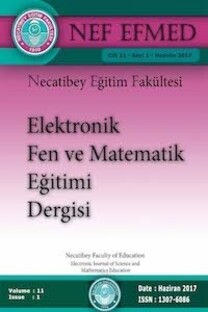The Potential of GeoGebra Software for Providing Mathematical Communication in the Light of Pre-service Teachers' Views
___
Ayvaz Reis, Z., & Özdemir, Ş. (2010). Using Geogebra as an information technology tool: Parabola teaching. Procedia-Social and Behavioral Sciences, 9, 565-572.Baki, A. (2008). Kuramdan uygulamaya matematik eğitimi (4. Basım). Ankara: Harf Eğitim Yayıncılık.
Brendefur, J., & Frykholm, J. (2000). Promoting mathematical communication in the classroom: Two preservice teachers' conceptions and practices. Journal of Mathematics Teacher Education, 3(2), 125-153.
Brenner, M. E. (1998). Development of mathematical communication in problem solving groups by language minority students. Bilingual Research Journal, 22(2-4), 149-174.
Choi, K. S. (2010). Motivating students in learning mathematics with GeoGebra. Annals Computer Science Series, 8(2), 65-76
Cooke, B. D., & Buchholz, D. (2005). Mathematical communication in the classroom: A teacher makes a difference. Early Childhood Education Journal, 32(6), 365-369.
Creswell, J.W. (2007). Qualitative inquiry and research design: Choosing among five traditions (2nd ed.). London: Sage.
Dienes, Z. P. (1971). An example of the passage from the concrete to the manipulation of formal systems. Educational Studies in Mathematics, 3(3), 337-352.
Dikovic, L. (2009a). Applications GeoGebra into teaching some topics of mathematics at the college level. Computer Science and Information Systems, 6(2), 191-203.
Dikovic, L. (2009b). Implementing dynamic mathematics resources with GeoGebra at the college level. International Journal of Emerging Technologies in Learning (iJET), 4(3), 51-54.
Furner, J. M., & Marinas, C. A. (2012). Connecting geometry, measurement, and algebra using GeoGebra for the elementary grades. Twenty-fourth Annual International Conference on Technology in Collegiate Mathematics (pp. 63-72). Orlando, Florida: Pearson Education Inc.
Hirschfeld-Cotton, K. (2008). Mathematical communication, conceptual understanding, and students' attitudes toward mathematics. Unpublished Master thesis. University of Nebraska, Lincoln, USA.
Hohenwarter, J., & Hohenwarter, M. (2012). Introduction to GeoGebra4. Available from www.geogebra.org.
Hohenwarter, M., & Jones, K. (2007). Ways of linking geometry and algebra, the case of Geogebra. Proceedings of the British Society for Research into Learning Mathematics, 27(3), 126-131.
Hohenwarter, M., Hohenwarter, J., Kreis, Y., & Lavicza, Z. (2008). Teaching and learning calculus with free dynamic mathematics software GeoGebra. In 11th International Congress on Mathematical Education. Monterrey, Nuevo Leon, Mexico.
Kutluca, T., & Zengin, Y. (2011). Matematik öğretiminde GeoGebra kullanımı hakkında öğrenci görüşlerinin değerlendirilmesi. Dicle Üniversitesi Ziya Gökalp Eğitim Fakültesi Dergisi, 17, 160-172.
Lipeikiene, J. (2009). Development of a Mathematical Communication Curriculum. Information Sciences, 50, 107-111.
McGuffey, W. C. (2015). Using Strategy Games and GeoGebra to Develop Understanding of Mathematical Language. MathAMATYC Educator, 6 (3), 51-60.
McMillan, J., & Schumacher, S. (2010). Research in education: Evidence-based inquiry (7th ed.). Boston, MA: Pearson.
Merriam, S. B. (1998). Qualitative Research and Case Study Applications in Education (2nd ed.). San Francisco: Jossey Bass Publishers.
Milli Eğitim Bakanlığı [MEB], (2013). Ortaöğretim matematik dersi (9, 10, 11 ve 12. sınıflar) öğretim programı. Ankara.
National Council of Teachers of Mathematics [NCTM], (2005). Principles and standarts for school mathematics. Reston, VA: NCTM.
Ng, O. L. (2016). Comparing calculus communication across static and dynamic environments using a multimodal approach. Digital Experiences in Mathematics Education, 2(2), 1-27.
Slavin, R. E. (1995). Cooperative learning theory, research, and practice (2nd ed.). Needham Heights, MA: Allyn and Bacon.
Stahl, G., Çakir, M. P., Weimar, S., Weusijana, B. K., & Ou, J. X. (2010). Enhancing mathematical communication for virtual math teams. Acta Didactica Napocensia, 3(2), 101-114.
Yackel, E., Cobb, P. & Wood, T. (1993). Developing a basis for mathematical communication within small groups. In T. Wood, P. Cobb, E. Yackel, & D. Dillon (Eds.), Rethinking elementary school mathematics: Insights and issues, Journal for Research in Mathematics Education Monograph No. 6 (pp. 33 - 44). Reston, VA: NCTM.
Yıldırım, A., & Şimşek, H. (2011). Sosyal bilimlerde nitel araştırma yöntemleri (8. bs.). Ankara: Seçkin Yayıncılık.
Yin, R. (1981). The case study crisis: Some answers. Administrative Science Quarterly,26(1), 58-65.
Yin, R.K.(2003). Case study research (Design and Methods).California: Sage Publication
Zengin, Y. (2011). Dinamik matematik yazılımı GeoGebra’nın öğrencilerin başarılarına ve tutumlarına etkisi. Yayımlanmamış Yüksek Lisans Tezi. Kahramanmaraş Sütçü İmam Üniversitesi Fen Bilimleri Enstitüsü. Kahramanmaraş.
Zengin, Y. (2015). Dinamik matematik yazılımı destekli işbirlikli öğrenme modelinin ortaöğretim cebir konularının öğrenimi ve öğretiminde uygulanabilirliğinin incelenmesi. Yayımlanmamış doktora tezi. Atatürk Üniversitesi, Erzurum.
- ISSN: 1307-6086
- Yayın Aralığı: 2
- Başlangıç: 2007
- Yayıncı: Balıkesir Üniv. Necatibey Eğitim Fak.
Türkiye’nin Pisa’daki Fen Başarısıyla İlişkili Faktörlerin İncelenmesi
Eda ERDAS KARTAL, Nihal DOGAN, Selda YILDIRIM
Yansıtıcı Düşünmeye Dayalı Etkinliklerin Bilimsel Süreç Becerilerinin Gelişimine Etkisi
Öğrenme Sorumluluğu Ölçeğinin Geliştirilmesi
QR Kodların Fen Eğitimine Entegresyonu: Öğretmen Görüşleri ve Öneriler
Engin KARAHAN, Sedef CANBAZOĞLU BİLİCİ
Analojilerin Fen Eğitimindeki Yeri ve Önemi
Şule SARIBAŞ, Yaşare AKTAŞ ARNAS
The Effects Of Reflective Thinking Activities On Science Process Skills
EMRE YILDIZ, ÜMİT ŞİMŞEK, Hakan ARAS
Mathematics Examination Anxiety Scale for Middle School Students: A Scale Development Study
